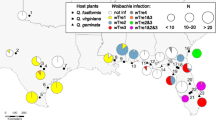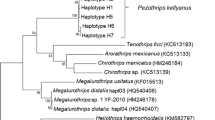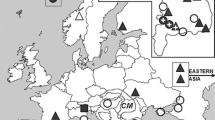Abstract
The process of loss or gain of parasites during invasion of new lands is not well understood. The alfalfa weevil Hypera postica is an invasive pest of various leguminous crops and consists of three major mitochondrial haplotypes, ‘Western’, ‘Egyptian’ and ‘Eastern’. The Western strain is infected with the endosymbiotic proteobacteria Wolbachia, that cause unidirectional complete reproductive incompatibility, in its native (Europe) and an introduced (the United States) ranges. However, our preliminary screening of a few introduced populations in Northern Kyushu, southwestern Japan, failed to detect Wolbachia from the Western strain. A larger-scale and historical assessment of Wolbachia infection may allow to estimate when and how the bacteria were lost, and current geographical distribution of infection among host haplotypes. In this study, we aim to assess the Wolbachia-infection status of H. postica populations throughout Northern Kyushu, where H. postica invasion to Japan was first found. A total of 228 individuals from seven regions in Northern Kyushu collected in different time periods from 1982 to 2015 and 14 individuals from Europe were subjected to PCR diagnostics for Wolbachia. Wolbachia from the Western strain was not detected, irrespective of the time periods and geographic areas in Northern Kyushu. We found ‘Egyptian’-strain H. postica collected most recently from an island off Kyushu harboured a supergroup-B Wolbachia variant. This variant was genetically different from the European Wolbachia variant infecting Western-strain H. postica. The infection was new to the Egyptian haplotype and was estimated to have taken place independently of the loss in the Western strain.



Similar content being viewed by others
References
Ahrens ME, Shoemaker D (2005) Evolutionary history of Wolbachia infections in the fire ant Solenopsis invicta. BMC Evol Biol 5:35
Augustin S, Courtin C, Rejasse A, Lorme P, Genissel A, Bourguet D (2004) Genetics of resistance to transgenic Bacillus thuringiensis poplars in Chrysomela tremulae (Coleoptera: Chrysomelidae). J Econ Entomol 97:1058–1064
Baldo L, Hotopp JCD, Jolley KA, Bordenstein SR, Biber SA, Choudhury RR, Hayashi C et al (2006) Multilocus sequence typing system for the endosymbiont Wolbachia pipientis. Appl Environ Microbiol 72:7098–7110
Bandi C, Anderson CG, Genchi C, Blaxter ML (1998) Phylogeny of Wolbachia in filarial nematodes. Proc R Soc Lond B Biol 265:2407–2413
Böttger JAA, Bundy CS, Oesterle N, Hanson SF (2013) Phylogenetic analysis of the alfalfa weevil complex (Coleoptera: Curculionidae) in North America. J Econ Entomol 106:426–436
Clancy DJ, Hoffmann AA (1998) Environmental effects on cytoplasmic incompatibility and bacterial load in Wolbachia-infected Drosophila simulans. Entomol Exp Appl 86:13–24
Cordaux R, Michel-Salzat A, Bouchon D (2001) Wolbachia infection in crustaceans: novel hosts and potential routes for horizontal transmission. J Evol Biol 14:237–243
Crain PR, Mains JW, Suh E, Huang YX, Crowley PH, Dobson SL (2011) Wolbachia infections that reduce immature insect survival: predicted impacts on population replacement. BMC Evol Biol 11:290
Darby AC, Armstrong SD, Bah GS, Kaur G, Hughes MA, Kay SM et al (2012) Analysis of gene expression from the Wolbachia genome of a filarial nematode supports both metabolic and defensive roles within the symbiosis. Genome Res 22:2467–2477
Dobson SL, Bourtzis K, Braig HR, Jones BF, Zhou WG, Rousset F, O’Neill SL (1999) Wolbachia infections are distributed throughout insect somatic and germ line tissues. Insect Biochem Mol Biol 29:153–160
Dykstra HR, Weldon SR, Martinez AJ, White JA, Hopper KR, Heimpel GE, Asplen MK, Oliver KM (2014) Factors limiting the spread of the protective symbiont Hamiltonella defensa in Aphis craccivora aphids. Appl Environ Microbiol 80:5818–5827
Erney SJ, Pruess KP, Danielson SD, Powers TO (1996) Molecular differentiation of alfalfa weevil strains (Coleoptera: Curculionidae). Ann Entomol Soc Am 89:804–811
Gotoh T, Noda H, Hong XY (2003) Wolbachia distribution and cytoplasmic incompatibility based on a survey of 42 spider mite species (Acari: Tetranychidae) in Japan. Heredity 91:208–216
Hamm CA, Begun DJ, Vo A, Smith CCR, Saelao P, Shaver AO, Jaenike J, Turelli M (2014) Wolbachia do not live by reproductive manipulation alone: infection polymorphism in Drosophila suzukii and D. subpulchrella. Mol Ecol 23:4871–4885
Hayashikawa S, Takesaki K, Nishioka T (2010) The occurrence of the alfalfa weevil Hypera postica (Gyllenhal) after estivation and optimum time to control adults. Bull Kagoshima Pref Ins Agric Develop (Livestock Industry) 4:17–22 (in Japanese)
Hilgenboecker K, Hammerstein P, Schlattmann P, Telschow A, Werren JH (2008) How many species are infected with Wolbachia?—a statistical analysis of current data. FEMS Microbiol Lett 281:215–220
Holden PR, Brookfield JFY, Jones P (1993) Cloning and characterization of an ftsZ homologue from a bacterial symbiont of Drosophila melanogaster. Mol Gen Genet 240:213–220
Hsiao TH (1996) Studies of interactions between alfalfa weevil strains, Wolbachia endosymbionts and parasitoids. In: Symondson WOC, Liddell JE (eds) The ecology of agricultural pests: biochemical approaches. Chapman & Hall, London, pp 57–71
Hsiao TH, Hsiao C (1985) Hybridization and cytoplasmic incompatibility among alfalfa weevil strains. Entomol Exp Appl 37:155–159
Iwase S, Tani S (in press) A new haplotype and inter-strain reproductive compatibility of Wolbachia-uninfected alfalfa weevil, Hypera postica (Coleoptera: Curculionidae), in Japan. Entomol Sci
Iwase S, Nakahira K, Tuda M, Kagoshima K, Takagi M (2015) Host-plant dependent population genetics of the invading weevil Hypera postica. B Entomol Res 105:92–100. doi:10.1017/S0007485314000728
Jansen VAA, Turelli M, Godfray HCJ (2008) Stochastic spread of Wolbachia. Proc R Soc B 275:2769–2776
Keane RM, Crawley MJ (2002) Exotic plant invasions and the enemy release hypothesis. Trends Ecol Evol 17:164–170
Kim CG, Zhou HZ, Imura Y, Tominaga O, Su ZH, Osawa S (2000) Pattern of morphological diversification in the Leptocarabus ground beetles (Coleoptera: Carabidae) as deduced from mitochondrial ND5 gene and nuclear 28S rDNA sequences. Mol Biol Evol 17:137–145
Kimura H, Okumura M, Yoshida T (1988) Emergence of and recent damage by the alfalfa weevil. Plant Prot 42:498–501 (in Japanese)
Kondo N, Ijichi N, Shimada M, Fukatsu T (2002) Prevailing triple infection with Wolbachia in Callosobruchus chinensis (Coleoptera: Bruchidae). Mol Ecol 11:167–180
Kondo NI, Tuda M, Toquenaga Y, Lan YC, Buranapanichpan S, Horng SB, Shimada M, Fukatsu T (2011) Wolbachia infections in world populations of bean beetles (Coleoptera: Chrysomelidae: Bruchinae) infesting cultivated and wild legumes. Zool Sci 28:501–508
Kuwata R, Tokuda M, Yamaguchi D, Yukawa J (2005) Coexistence of two mitochondrial DNA haplotypes in Japanese populations of Hypera postica (Col., Curculionidae). J Appl Entomol 129:191–197
Maund CM, Hsiao TH (1991) Differential encapsulation of two Bathyplectes parasitoids among alfalfa weevil strains, Hypera postica (Gyllenhal). Can Entomol 123:197–203
McManus PS, Stockwell VO, Sundin GW, Jones AL (2002) Antibiotic use in plant agriculture. Annu Rev Phytopathol 40:443–465
Mitchell CE, Power AG (2003) Release of invasive plants from fungal and viral pathogens. Nature 421:625–627
Moji Plant Protection Station (2007) Natural enemies introduction promotion project report—utilization of parasitoids of the alfalfa weevil. Moji Plant Protection Station, Fukuoka (in Japanese)
Moreira LA, Iturbe-Ormaetxe I, Jeffery JA, Lu G, Pyke AT, Hedges LM, Rocha BC, Hall-Mendelin S et al (2009) A Wolbachia symbiont in Aedes aegypti limits infection with dengue, Chikungunya, and Plasmodium. Cell 139:1268–1278
Mori M, Haitsuka S, Ogata K, Jinnouchi H, Abe K (1991) Chemical control of alfalfa weevil, Hypera postica (Gyll.) on Chinese milk vetch. Proc Assoc Plant Prot Kyushu 37:209–211 (in Japanese)
Muller MJ, Dorr NCD, Depra M, Schmitz HJ, Valiati VH, Valente VLD (2013) Reevaluating the infection status by the Wolbachia endosymbiont in Drosophila neotropical species from the willistoni subgroup. Infect Genet Evol 19:232–239
Narita S, Nomura M, Kageyama D (2007) Naturally occurring single and double infection with Wolbachia strains in the butterfly Eurema hecabe: transmission efficiencies and population density dynamics of each Wolbachia strain. FEMS Microbiol Ecol 61:235–245
Nylander JAA (2004) MrAIC.pl. Program distributed by the author. Evolutionary Biology Centre, Uppsala University, Uppsala
Okumura M (1991) Alfalfa weevil (Hypera postica)—a serious pest of Chinese milk vetch. Honeybee Sci 12:145–150 (in Japanese)
Okumura M, Shiraishi A (2002) Establishment of the alfalfa weevil parasitoid and its potential for biological control. Plant Prot 56:329–333 (in Japanese)
Oliver KM, Russell JA, Moran NA, Hunter MS (2003) Facultative bacterial symbionts in aphids confer resistance to parasitic wasps. Proc Natl Acad Sci USA 100:1803–1807
O’Neill SL, Giordano R, Colbert AM, Karr TL, Robertson HM (1992) 16S rRNA phylogenetic analysis of the bacterial endosymbionts associated with cytoplasmic incompatibility in insects. Proc Natl Acad Sci USA 89:2699–2702
Rambaut A, Drummond AJ (2009) Tracer v1.5. http://beast.bio.ed.ac.uk/
Richardson MF, Weinert LA, Welch JJ, Linheiro RS, Magwire MM, Jiggins FM, Bergman CM (2012) Population genomics of the Wolbachia endosymbiont in Drosophila melanogaster. PLoS Genet 8:e1003129
Ronquist F, Huelsenbeck JP (2003) MrBayes 3: Bayesian phylogenetic inference under mixed models. Bioinformatics 19:1572–1573
Sarakatsanou A, Diamantidis AD, Papanastasiou SA, Bourtzis K, Papadopoulos NT (2011) Effects of Wolbachia on fitness of the Mediterranean fruit fly (Diptera: Tephritidae). J Appl Entomol 135:554–563
Schneider DI, Klasson L, Lind AE, Miller WJ (2014) More than fishing in the dark: PCR of a dispersed sequence produces simple but ultrasensitive Wolbachia detection. BMC Microbiol 14:121
Skuhrovec J (2005) Host plants of weevils of the genus Hypera (Coleoptera: Curculionidae) occurring in the Czech Republic. Klapalekiana 41:215–255
Suh E, Dobson SL (2013) Reduced competitiveness of Wolbachia infected Aedes aegypti larvae in intra- and inter-specific immature interactions. J Invertebrate Pathol 114:173–177
Torchin ME, Lafferty KD, Dobson AP, McKenzie VJ, Kuris AM (2003) Introduced species and their missing parasites. Nature 421:628–630
Tsutsui ND, Kauppinen SN, Oyafuso AF, Grosberg RK (2003) The distribution and evolutionary history of Wolbachia infection in native and introduced populations of the invasive Argentine ant (Linepithema humile). Mol Ecol 12:3057–3068
Tuda M, Wasano N, Kondo N, Horng S-B, Chou L-Y, Tateishi Y (2004) Habitat-related mtDNA polymorphism in the stored-bean pest Callosobruchus chinensis (Coleoptera:Bruchidae). B Entomol Res 94:75–80
Werren JH (1997) Biology of Wolbachia. Annu Rev Entomol 42:587–609
Werren JH, Zhang W, Guo LR (1995) Evolution and phylogeny of Wolbachia: reproductive parasites of arthropods. Proc R Soc Lond B Biol 251:55–63
Werren JH, Baldo L, Clark ME (2008) Wolbachia: master manipulators of invertebrate biology. Nat Rev Microbiol 6:741–751
Wood KA, Armbrust EJ, Bartell DP, Irwin BJ (1978) The literature of arthropods associated with alfalfa. V. a bibliography of the alfalfa weevil, Hypera postica (Gyllenhal), and the Egyptian alfalfa weevil, Hypera brunneipennis (Boheman) (Coleoptera: Curculionidae). Illin Agric Exper Station, Special Publ 54
Yamaguchi T, Inoue H, Horimoto M, Yamamoto S (1993) Ecology and control of alfalfa weevil, Hypera postica (Gyll.) in Kagoshima. 3. Timing and methods of chemical control. Proc Assoc Plant Prot Kyushu 39:142–145 (in Japanese)
Yang C-C, Yu Y-C, Valles SM, Oi DH, Chen Y-C, Shoemaker D, Wu W-J, Shih C-J (2010) Loss of microbial (pathogen) infections associated with recent invasions of the red imported fire ant Solenopsis invicta. Biol Invasions 12:3307–3318
Zug R, Hammerstein P (2012) Still a host of hosts of Wolbachia: analysis of recent data suggests that 40 % of terrestrial arthropod species are infected. PLoS ONE 7:e38544
Acknowledgments
We thank R. Kuwata for providing the H. postica specimens collected in 2001/2002. This study was performed as part of the Ph.D. research of SI and was supported by Grants-in-Aid from the Japan Society for the Promotion of Science (KAKENHI 23405008 and 25430194) and by Kyushu University Interdisciplinary Programs in Education and Projects in Research Development (25412) to M. Tuda, and by a Grant from the Czech Ministry of Agriculture (Mze ČR) RO0415 to JS.
Author information
Authors and Affiliations
Corresponding author
Rights and permissions
About this article
Cite this article
Iwase, S., Tani, S., Saeki, Y. et al. Dynamics of infection with Wolbachia in Hypera postica (Coleoptera: Curculionidae) during invasion and establishment. Biol Invasions 17, 3639–3648 (2015). https://doi.org/10.1007/s10530-015-0985-1
Received:
Accepted:
Published:
Issue Date:
DOI: https://doi.org/10.1007/s10530-015-0985-1




